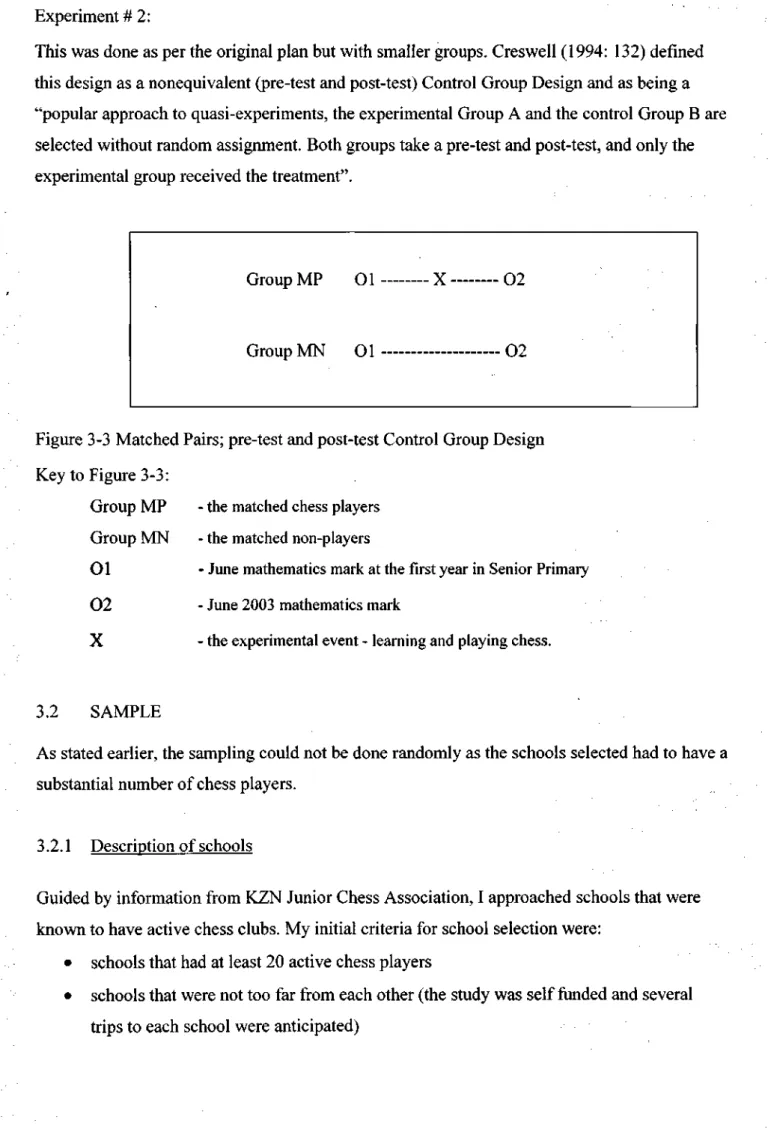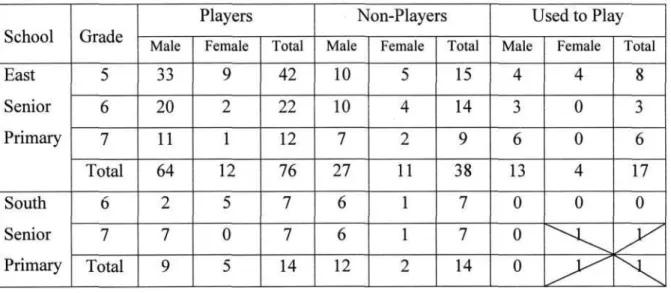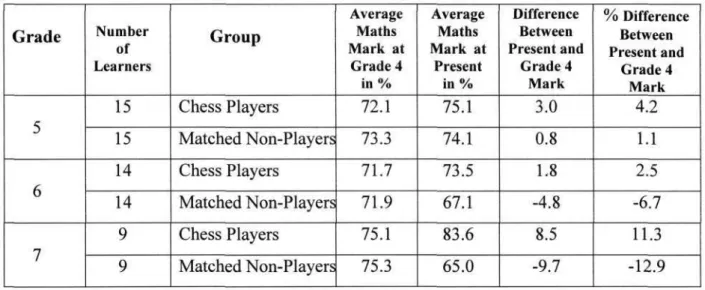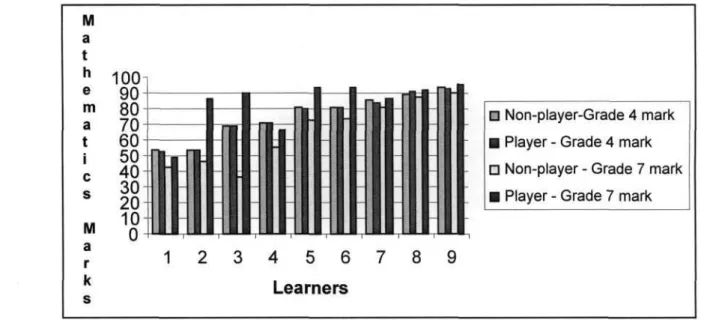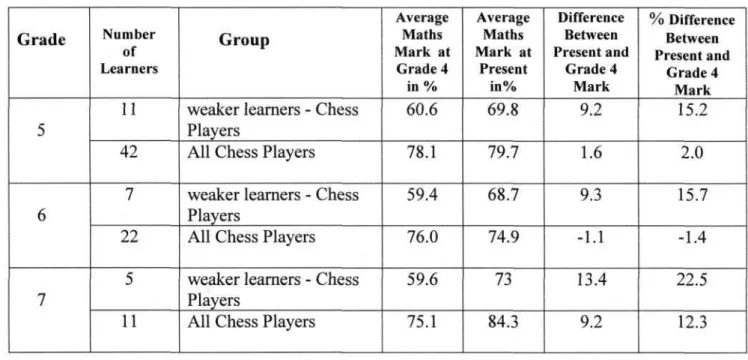Pupils from two Senior Primary Schools in Kwazulu-Natal which had active school chess clubs were selected to participate in the study. Students' average mathematics grades at the entry year of their Senior Primary Schools were considered as pretest data.
RESEARCH APPROACH
This study aimed to find out whether learners who learned to play chess, and played the game for several years, consequently performed better in Mathematics. The qualitative data was obtained by analyzing learners' responses about their playing habits, their attitude towards the game and the possible contribution of the game to their academic performance.
STRUCTURE
Teacher interview which provided lists of active chess players and further general information about their schools and learners. The quantitative data was obtained by measuring and analyzing changes in mathematics performance for the chess players.
LITERATURE REVIEW
INTRODUCTION
CHESS
Again, the test group consisted of only 14 students and the researcher encouraged replication of the study. Like some international studies, Van Zyl focused on high-level chess players.
MATHEMATICS
While dealing directly with the learning domain of mathematics, we must not overlook the development of the more "general" skills required for mathematics. The ability to formulate, represent and solve mathematical problems (strategic competence) as well as the ability to think logically, reason and interpret (flexible reasoning) can be compared to some of the skills a player acquires while developing chess skills.
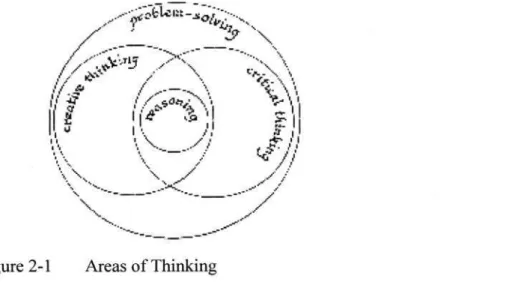
CONCLUSION
The overlap of cognitive skills required by chess and mathematics suggests that the development of these skills in chess is likely to result in a transfer to mathematics.
DESIGN OF STUDY
Senior Primary learners, from each of two schools, who were active chess players in June 2003, were identified and selected to participate in the study (details on process of identification, criteria for selection and limitation are discussed in sections 3.2, 3.3 & 3.5 ). For each selected chess player (who was in group A), his mathematics score as appeared in his school records in the first year at the Senior Primary School was obtained. X's and O's vertically next to each other are simultaneous.
A random selection of schools would have been impossible as this study focuses on the mathematical performance of students who are chess players and the schools selected had to be those that have ongoing chess activities/clubs and therefore have students who are chess players. As will be explained in detail in section 3.2, during the matching process and the search for a non-player student for each of the chess players for one of the schools, it became clear that a 100% match was not achievable and that if we were strictly If we wanted to stick to the original experiment design, a large part of the data on chess players would become unusable. Creswell defined this design as a non-equivalent (pre-test and post-test) control group design and as a.
34; popular approach to quasi-experiments, experimental group A and control group B are selected without random assignment.
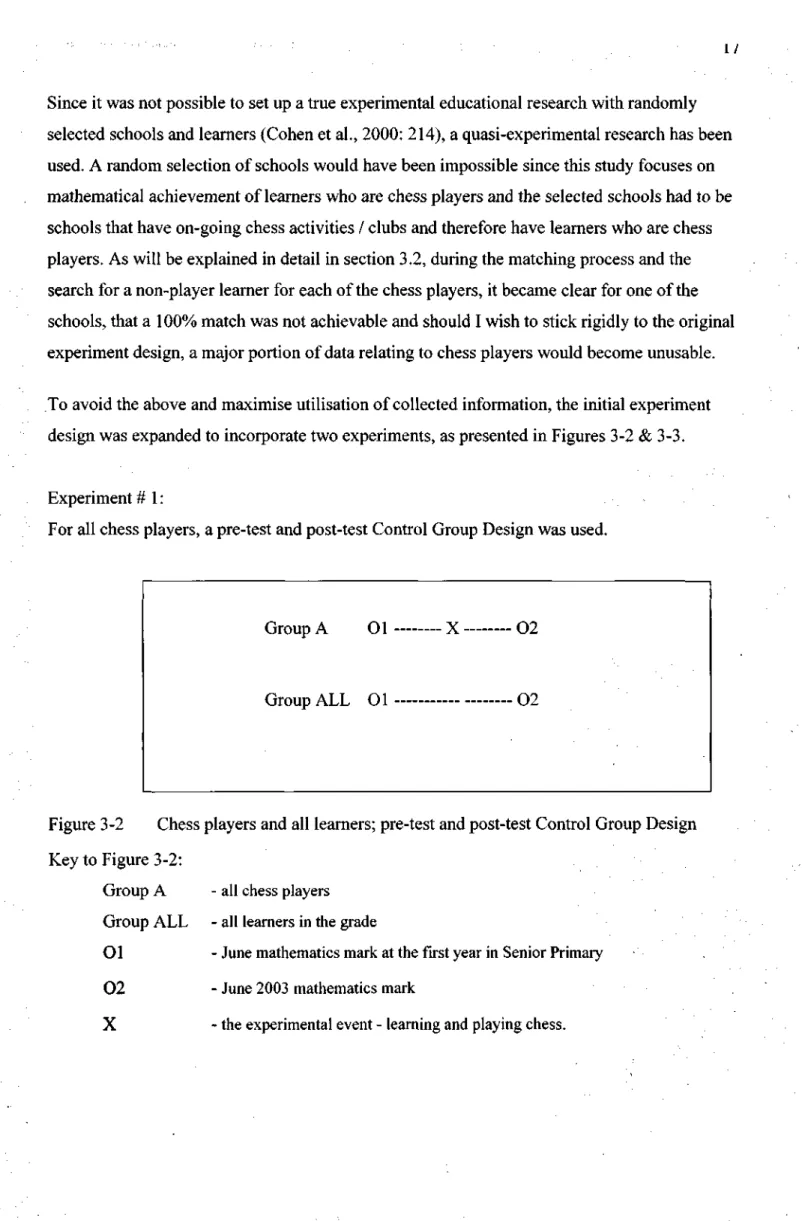
SAMPLE
Of the schools that met the criteria, two Senior Primary Schools within the eThekwini Municipality agreed to participate in the study. For the purpose of this study, the school was referred to as South Senior Primary School. The exclusion applied to all grade 4 players at Laerskool Oos Senior (the school has grade 4 to grade 7 learners) and to all grade 5 players at Laerskool Suid-Senior (the school has grade 5 to grade 7 learners) ).
As detailed in table 3-2, resulting from the information obtained from the questionnaire (section 3.3.3), the original categorization of the participants changed (non-players moved to players and to used to play categories) and a few non-players have been added in order to obtain a larger number of matching pairs. The only learner who used to play at the South Senior Primary School was excluded from the study as no analysis could take place. The number of chess players at Laerskool Suid Senior was few compared to Laerskool Oos Senior and the teacher in charge knew all players well.
At the upper elementary school Jug, all chess players filled out a questionnaire during their daily after-school chess activity.
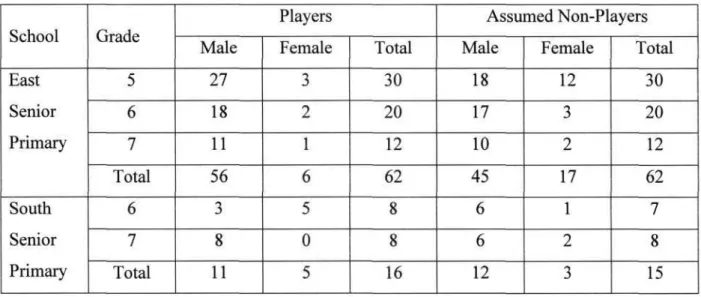
ANALYSIS OF DATA
One grade 6 player had to be excluded because his grade 5 math grade was not available. Both the "new-found" chess players and the students used to playing chess, who were originally assumed to be non-players, had to be moved from the groups of their matched non-players to the appropriate groups. The matching process had to be redone in an attempt to find non-player students who could be matched with the 'newly found' chess players, as well as with the originally identified players who lost their 'match'.
The analysis was related to the research questions by examining changes in mean math scores for different subgroups. According to Bohrnstedt & Knoke (1982), the t-test is "a test of significance for continuous variables where the population variance is unknown and the sample is assumed to be. Because no randomization was used, neither in the selection of schools nor in the selection of students in a school is t-test should be used with caution.
While the samples were small, it was assumed that the population from which they were drawn was not "grossly abnormal" and therefore the t-test could be used.
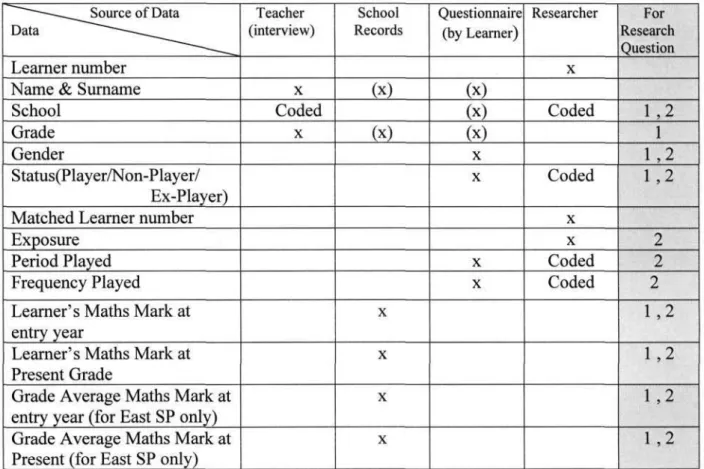
LIMITATIONS OF STUDY
However, Bohrnstedt & Knoke (1982) believed that the sampling assumption was too restrictive and suggested that the test could be used, "unless we are certain that the underlying population from which the sample is drawn is grossly non-normal, may we use t -test to test a hypothesis even when N is small" (Bohrnstedt & Knoke.
CONCLUSION
INTRODUCTION
RESULTS FOR RESEARCH QUESTION # 1
The first set of analyzes was conducted on well-known chess players at East Senior High School in grades 5, 6, and 7. The most interesting finding concerned chess players whose math achievement in 4th grade was below the class average. Below average scores - These were chess players who scored below average in math in 4th grade.
The difference between the average mathematics scores of weaker students (in 4th grade) of chess players and their corresponding non-players increased from 0% in 5th grade to 12.1% in 6th grade and further to 27.8% in 7th grade. However, as presented in Table 4-6, all female chess players at East Upper Elementary School who were weak. As shown in Figure 4-3, the majority of former chess players (five out of six) scored lower in math in 7th grade compared to their 4th grade scores.
The comparison between changes in mathematics achievement for chess players and their matched non-players at South Elementary School is presented in Table 4-10.
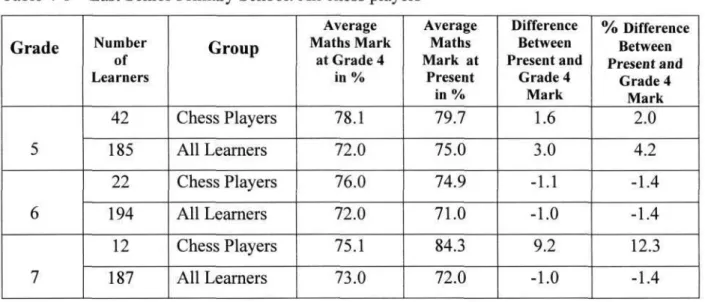
RESULTS FOR RESEARCH QUESTION # 2
DESCRIPTION OF PARTICIPANTS
Only a few of the East Senior Primary players play for clubs, but none of the South Senior Primary players played for a club. While all players from South Senior Primary School played in tournaments, only 33% of Grade 7 chess players from East Senior Primary played in tournaments. Although the majority of students at East Senior Primary School also played with family (88.2%), this was not the case at South Senior Primary School.
The majority of players from both schools (71.1% at East Senior Primary and 100% at South Senior Primary) felt that chess helped them with their schoolwork. At South Senior Primary, all Year 7 players felt that playing chess helped them with maths, while Year 6 students split their votes between the three categories. Just eight players from East Senior Primary (all Year 5 and 6) wrote comments, mostly describing the game as "fun" and "cool".
Many of the East Upper Primary students just marked themselves as non-players without giving a reason.
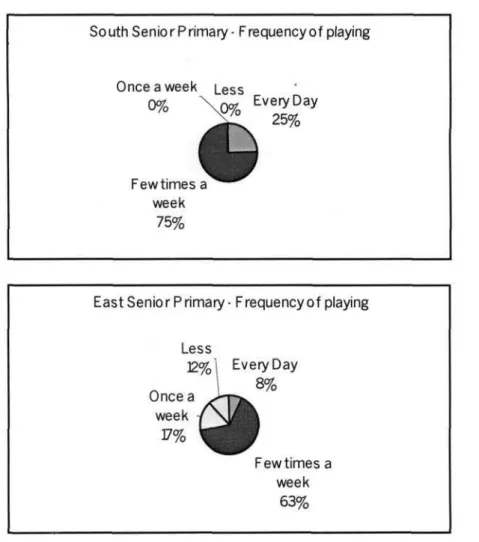
SUMMARY
It was interesting to find out why learners who used to play stopped playing. Since only one former player has been identified at the South Senior Primary, Table 4-17 is only a summary of data for the East Senior Primary Former players.
CONCLUSIONS AND RECOMMENDATIONS
CONCLUSIONS
Van Zyl's study confirmed improved performance in math from 8th grade - which is outside the age range of this study. Ferguson's study of gifted students was conducted on students who were older than the students who participated in this study. As this study did not go beyond grade 7, it is impossible to conclude whether there would have been further improvements in the higher grade.
No correlation was found between the level of exposure to chess and the improvement in mathematical performance. Although several related studies focused on relatively high-level or experienced players (Horgan, 1987, Van Zyl, 1991), the 'level' of chess in this study was not reached and thus not linked to exposure. Exposure to chess is a combination of the period the chess player has played chess and the frequency played during that period.
Therefore, no conclusions should be drawn about the possible relationship between the 'level' of chess and performance in mathematics.
RECOMMENDATIONS
The results of this study, mainly pointing to the positive effect of chess playing on mathematical achievement in the upper class at the upper primary level, further reinforced the results of other studies related to the contribution of chess to mathematical skills and achievement. Since this study was conducted in primary and secondary schools and the most positive results were obtained for the last grade in the secondary class - grade 7, it is likely that further research at the secondary school level will enable it to be proven whether the positive effect of playing chess on mathematics is preserved in higher grade achievement. This study provides strong evidence that chess can be used as one of the tools to increase student achievement.
2002, "The Impact of Chess Playing on Academic Performance and Mathematics Outcomes in Northlands Primary School", Unpublished Research Project, M.Ed. 1991, "The Importance of Playing Chess in Improving the Child's Mental Actualization", PhD Dissertation, University of Pretoria, South Africa. 2 South Elementary - Student's current class P Active chess player N Non-player E Used to play chess m Male. a combination of Period Played and Game Frequency 1 low.
If the answer is NO. you can mark more than one block and add your reason).
